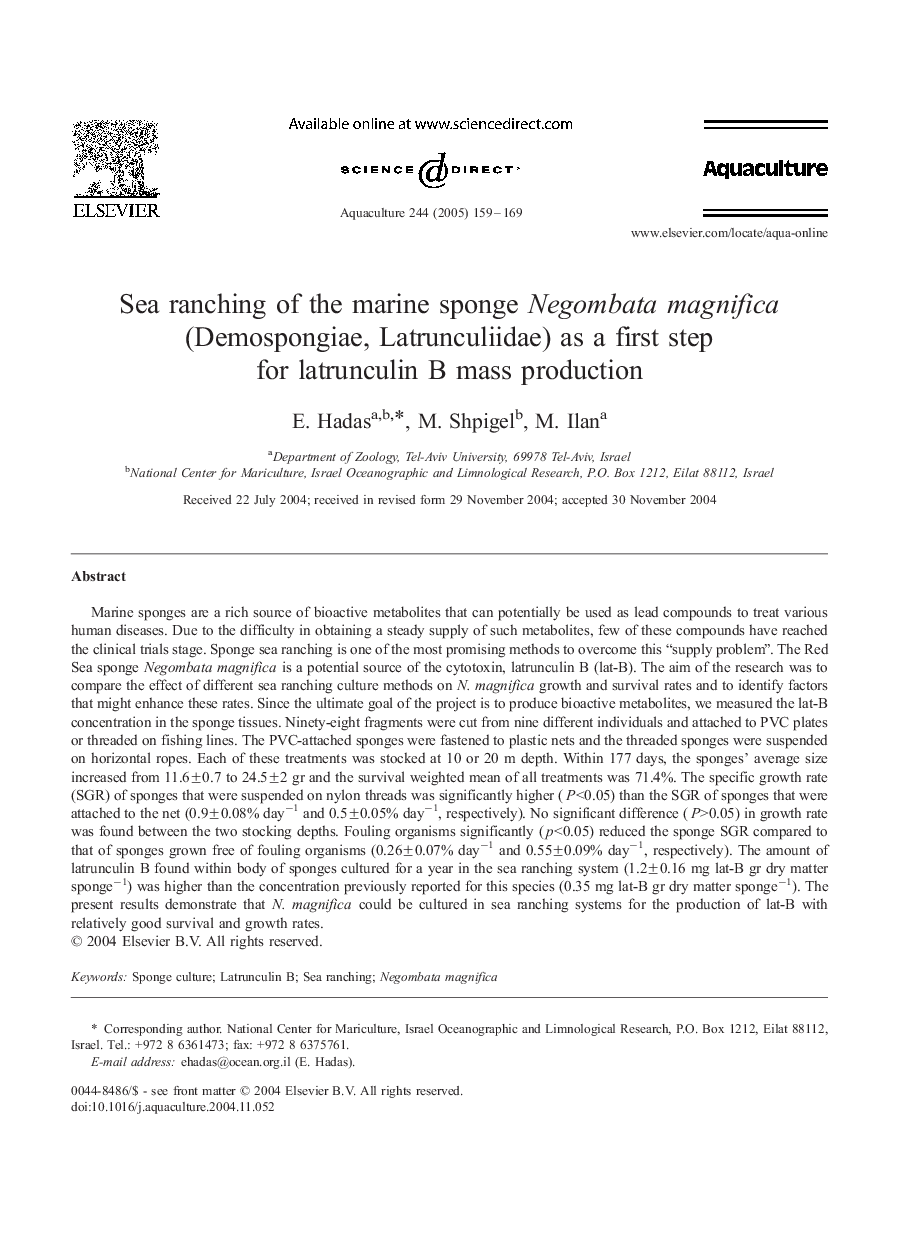| کد مقاله | کد نشریه | سال انتشار | مقاله انگلیسی | نسخه تمام متن |
|---|---|---|---|---|
| 8974909 | 1552998 | 2005 | 11 صفحه PDF | دانلود رایگان |
عنوان انگلیسی مقاله ISI
Sea ranching of the marine sponge Negombata magnifica (Demospongiae, Latrunculiidae) as a first step for latrunculin B mass production
دانلود مقاله + سفارش ترجمه
دانلود مقاله ISI انگلیسی
رایگان برای ایرانیان
کلمات کلیدی
موضوعات مرتبط
علوم زیستی و بیوفناوری
علوم کشاورزی و بیولوژیک
علوم آبزیان
پیش نمایش صفحه اول مقاله

چکیده انگلیسی
Marine sponges are a rich source of bioactive metabolites that can potentially be used as lead compounds to treat various human diseases. Due to the difficulty in obtaining a steady supply of such metabolites, few of these compounds have reached the clinical trials stage. Sponge sea ranching is one of the most promising methods to overcome this “supply problem”. The Red Sea sponge Negombata magnifica is a potential source of the cytotoxin, latrunculin B (lat-B). The aim of the research was to compare the effect of different sea ranching culture methods on N. magnifica growth and survival rates and to identify factors that might enhance these rates. Since the ultimate goal of the project is to produce bioactive metabolites, we measured the lat-B concentration in the sponge tissues. Ninety-eight fragments were cut from nine different individuals and attached to PVC plates or threaded on fishing lines. The PVC-attached sponges were fastened to plastic nets and the threaded sponges were suspended on horizontal ropes. Each of these treatments was stocked at 10 or 20 m depth. Within 177 days, the sponges' average size increased from 11.6±0.7 to 24.5±2 gr and the survival weighted mean of all treatments was 71.4%. The specific growth rate (SGR) of sponges that were suspended on nylon threads was significantly higher (P<0.05) than the SGR of sponges that were attached to the net (0.9±0.08% dayâ1 and 0.5±0.05% dayâ1, respectively). No significant difference (P>0.05) in growth rate was found between the two stocking depths. Fouling organisms significantly (p<0.05) reduced the sponge SGR compared to that of sponges grown free of fouling organisms (0.26±0.07% dayâ1 and 0.55±0.09% dayâ1, respectively). The amount of latrunculin B found within body of sponges cultured for a year in the sea ranching system (1.2±0.16 mg lat-B gr dry matter spongeâ1) was higher than the concentration previously reported for this species (0.35 mg lat-B gr dry matter spongeâ1). The present results demonstrate that N. magnifica could be cultured in sea ranching systems for the production of lat-B with relatively good survival and growth rates.
ناشر
Database: Elsevier - ScienceDirect (ساینس دایرکت)
Journal: Aquaculture - Volume 244, Issues 1â4, 28 February 2005, Pages 159-169
Journal: Aquaculture - Volume 244, Issues 1â4, 28 February 2005, Pages 159-169
نویسندگان
E. Hadas, M. Shpigel, M. Ilan,